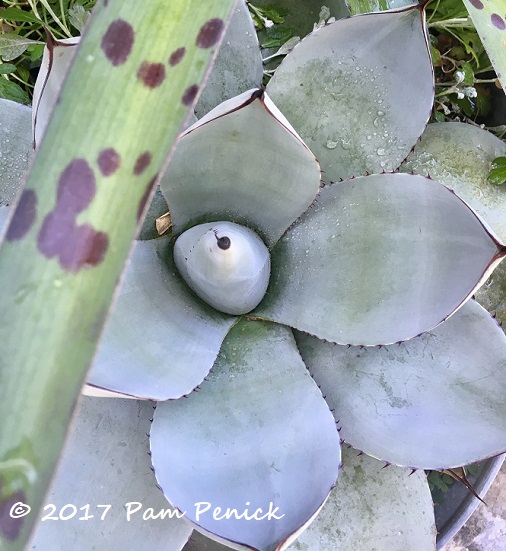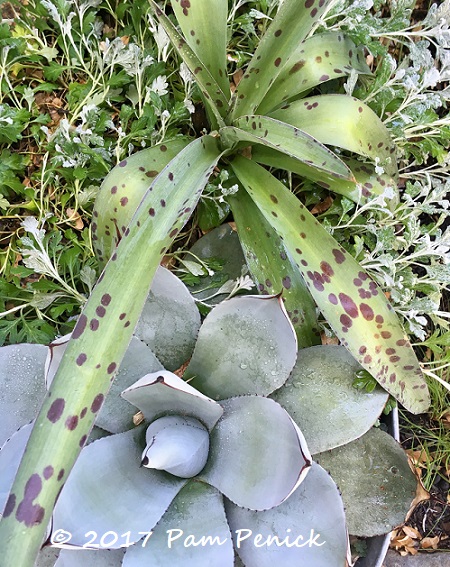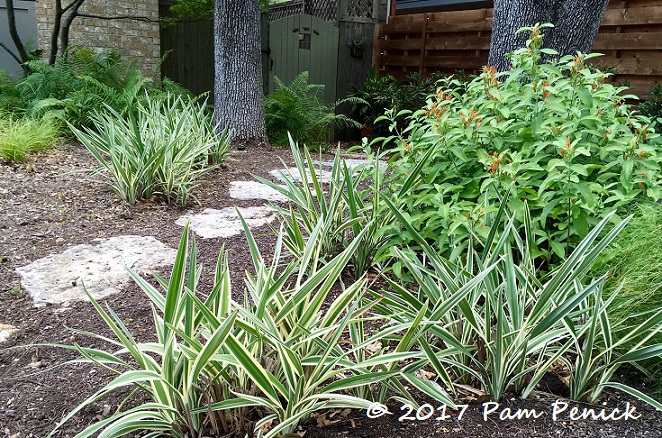Summer-tough Foliage Follow-Up
Summer is my most challenging season as a gardener. Yes, really — not winter. I don’t care at all for hot weather, so I retreat indoors and don’t venture outside much until that first hint of cooler air and lessening of the Death Star that typically occurs in early October. (And then I enjoy being outdoors from October through May, a good 8 months, so don’t feel sorry for my being cooped up all summer. It’s like a northerner’s winter.)
The plants in my garden don’t have the luxury of hanging out in the A/C, so they’ve got to be tough enough not only to withstand months of 95-to-100-degree heat, Gulf Coast humidity, and (sometimes) lack of rain but also the neglect of a summer-wimpy gardener.
I fear perhaps I overshare about such plants, like an adoring parent with a precocious child, but here I am again for Foliage Follow-Up, touting the beauty and toughness of winter-hardy agaves and succulents, like this container combo of Agave parryi var. truncata and Manfreda maculosa, aka Texas tuberose, a South Texas native. Neither heat nor cold has touched this slow-growing small agave. While the purple-spotted manfreda died back in last winter’s freezes, it sprang back quickly in the spring.
I also really like the ‘Quicksilver’ artemisia (a trial plant from Proven Winners) filling in around them. I don’t know if it would be overly aggressive if planted out in the garden, the way ‘Oriental Limelight’ artemisia can be. But in a container it’s perfectly behaved and looks great even when I forget to water. I’m growing this combo in bright shade with a little afternoon sun.
Another combo I’m always appreciative of in the summer is variegated flax lily (Dianella tasmanica ‘Variegata’) and Mexican honeysuckle (Justicia spicigera), which are not only heat tolerant but shade tolerant and deer resistant. They aren’t quite as winter hardy as I’d like in Austin’s hardiness zone 8b; both died back messily during last winter’s Arctic blast. But hey, they came back this spring and now look great, and on a hot summer’s day, what more can one ask of the garden?
This is my July post for Foliage Follow-Up. Fellow bloggers, what leafy loveliness is happening in your garden this month? Please join me in giving foliage its due on the day after Bloom Day. Leave a link to your post in a comment below. I’d appreciate it if you’ll also link to my post in your own — sharing link love! I look forward to seeing your foliage faves.
I welcome your comments; please scroll to the end of this post to leave one. If you’re reading this in a subscription email, click here to visit Digging and find the comment box at the end of each post.
_______________________
Digging Deeper: News and Upcoming Events
Get on the mailing list for Garden Spark Talks. Inspired by the idea of house concerts, I’m hosting a series of garden talks by talented designers and authors out of my home. Talks are limited-attendance events and generally sell out within just a few days, so join the Garden Spark email list for early notifications. Simply click this link and ask to be added.
All material © 2006-2017 by Pam Penick for Digging. Unauthorized reproduction prohibited.





I never tire of seeing your children in any form. I admire these plants. If I had a greenhouse my garden would look much different during summer as I would have many of these plants scattered about.
I often wish for a greenhouse too, Lisa. Many gardeners I know have one so they can protect their tender succulents and cactus. —Pam
I love your Agave and have even set up a couple of succulent planters on my outdoor patio to bring in a bit of the Gulf Coast look! I have some leafy loveliness to share for the month of July at http://landscapedesignbylee.blogspot.com/2017/07/garden-bloggers-bloom-day-foliage.html#.WWtj4YQrKUk Thanks for hosting!
If it weren’t for yesterdays sorta-kinda rain I wouldn’t have a post this month, so hooray for overcast afternoons! Here’s my foliage contribution: https://rabidgardener.blogspot.com/2017/07/foliage-follow-up-july-2017.html
It’s a never-ending source of fascination what gardeners in the same town can grow that I routinely kill (or I make the plants wish they were dead). Your Flax Lily look so great! Mine got rust and just looked miserable, so I’ll just adore yours and everyone else’s from afar!
Thanks so much for hosting, Pam!
Sometimes mine get rust too, but it hasn’t been bad enough that I’ve thought of pulling them out. No sign of it since they’ve come back after the freeze. —Pam
I wish my Dianella looked as good as yours! I often liken our summer to winters in the north too, although the Death Star isn’t as unforgiving here as it is in Austin. Our marine layer has been a frequent visitor this July and, even though it doesn’t hang around long, it takes some of the edge off for us. I managed to find some foliage that isn’t covered in the pink fuzz dropped by the mimosa tree this month: https://krispgarden.blogspot.com/2017/07/foliage-follow-up-july-2017.html
Hi Pam, What is the fern you have growing in the upper left background of the picture with the Mexican Honeysuckle? My Mexican Honeysuckle looks much like yours (same size and flowering at this point) after dying back from the freeze you mentioned. I’ve been wondering lately if I could boost flower production with fertilizing–when is it advisable (or not) to fertilize salvias, lantana, sages, Turk’s caps–are these “native” plants that do better with a little fertilization? Or do I risk killing them because they can’t handle it? I created the beds using the “lasagna gardening” technique, which created a nice loamy soil, but I have not been adding compost, only allowing leaves and mulch to break down.
That’s our native river fern, Thelypteris kunthii. It’s unbeatable for shade, especially along a dry creek where it gets a little more water from time to time. It dies back in the winter (so don’t put it right by your front door or in a highly visible place) but comes back in spring and slowly spreads.
As for fertilizing native plants, that’s something I’m still figuring out myself. I figure plants like Turk’s cap and Mexican honeysuckle, which do well in clay (i.e., richer soil), appreciate a feeding more than plants that thrive in lean, gravelly soils, like salvias. I rarely feed my plants, although I do usually bring in a few inches of gravelly composted soil to mix in when I first plant, just to increase drainage and fertility.
Because we had that surprising deep freeze last winter that really knocked back the plants, and also because I knew I’d be sharing my garden with photographers a few times this year and next, I decided to feed my garden this year. I applied a few inches of compost through all my garden beds except around yuccas, agaves, cactus, etc. I can’t recommend the compost brand because it was full of small shards of glass and hard plastic (!), but it does seem to be helping to give the plants a little boost. And I knew it would help my trees too (just don’t pile up compost around their trunks). I’m going to follow up with a fresh application of Texas native mulch this fall to finish everything off nice and neat. —Pam
My coleus are looking good right now. They are all in containers since they take some water. But my grandson, Gavin, age 3, is my helper when it comes to watering. We go out first thing to beat the heat and catch a glimpse of the hummingbirds. My Big Red Sage and Black and Blue Salvia are in bloom. But my purple coneflowers are looking a little crispy.
My purple coneflowers never last very long either, but they are pretty earlier in the year. It sounds like you and Gavin have a fun gardening routine! —Pam
I am amazed with your flax lily and Mexican honeysuckle. Mine also froze out this winter but are only about 6 inches high. Do you use large amounts of fertilizer or miracle grow? I bought more flax lily but put them in containers so I can bring them in this winter.
Hi Sasser. See my reply about feeding to Beverly above (#5). I wouldn’t recommend fertilizing with the blue stuff but going organic with a 2-inch layer of compost or, for a quick boost, an organic foliar spray-on application of Medina Hasta Gro.
It may be that I’m in a warmer pocket of Austin than you, if your flax lily and Mex honeysuckle are still struggling. Microclimates can make a big difference. But I would try feeding them with compost in early October to see if that makes a difference. —Pam
Southern gardeners will never tire of seeing thriving sunmer plants. Keep on with the inspiration!
Will do. Thanks, Heidi! —Pam
I recently visited family in Arizona and fell in love with agave! Such a cute plant! I learned a lot during that visit about beautiful plants that thrive in hot, dry climates.
Agaves are simply the sexiest plants out there. Arizona is a good place to discover them. Did you go to Desert Botanical Garden if you were in Phoenix? —Pam
Love it! Manfredas and even more so, xMangaves are slowly becoming my new must-haves. They don’t seem too unhappy in our heat so far. I have mostly spiky things for foliage follow up this month, but also a few soft leaves.
http://gardeninguptoeleven.blogspot.com/2017/07/foliage-follow-up-july-2017.html
Thanks for hosting Foliage Follow up!
I often think about how I can go inside into the air conditioning, but the plants/animals outside can’t. I feel especially bad for plants…they can’t even move out of the sun. Love the Manfreda maculosa.
It’s a wonderful container plant for sun or part shade, Rebecca. Looks especially nice with rock penstemon and Mexican feathergrass for a sunny container. —Pam
More and more I am choosing plants for their foliage rather than their blooms. You have such a rich variety of textures and shades of green in your garden, Pam. So beautiful. P. x
Thanks, Pam. Of course I’m always wishing for a greater variety than can grow in our hot-summer climate, but I do love our silver-blues and silver-greens. —Pam
From Each Little World: http://www.lindabrazill.com/each_little_world/2017/07/foliage-follow-up-july-2017.html